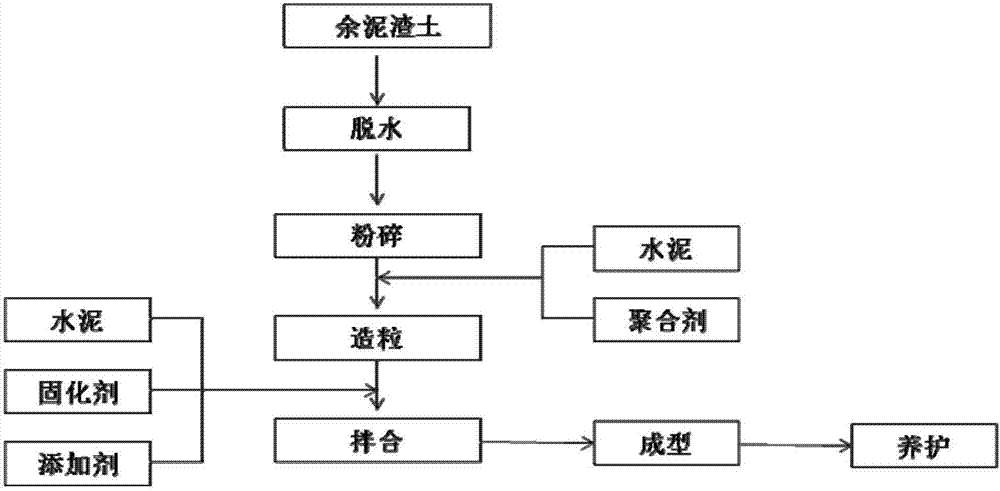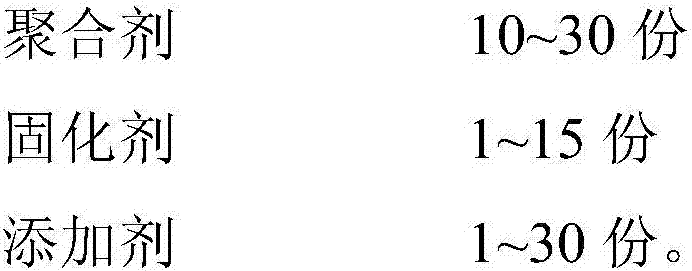Non-burnt brick prepared from unwanted soil residues and preparation method thereof
A technology of avoiding burning bricks and mud slag, which is applied in the direction of building components, buildings, building structures, etc., to achieve the effect of simple process, large processing capacity and solving a large amount of stockpiling
- Summary
- Abstract
- Description
- Claims
- Application Information
AI Technical Summary
Problems solved by technology
Method used
Image
Examples
preparation example Construction
[0032] The present invention also provides a method for preparing unfired bricks with residual mud and slag, figure 1 It is the production process flow chart of the preparation method of the residual mud slag soil unburned brick of the present invention, as figure 1 shown, including the following steps:
[0033] S100, using residual sludge as the main raw material, after being dehydrated and pulverized, mixed with cement and a polymerizing agent, and then granulated to form stabilized soil granules;
[0034] S200, uniformly mixing the stabilized soil particles with cement, curing agent, and additives, and pressing them into shape;
[0035] S300, curing under natural conditions for 7 to 14 days to obtain the burnt-free brick with residual mud and slag.
[0036] In another preferred embodiment of the present invention, in the step S100, the moisture content of the residue after dehydration treatment is <8%, and the particle size after pulverization is <5mm. The polymerizing a...
Embodiment 1
[0041] The unilateral ratio is based on 1500kg of residual sludge, 200kg of cement, 30kg of polymerizing agent, 15kg of curing agent and 30kg of additives. according to figure 1 The production process is to prepare unfired bricks with residual mud and slag, in which the amount of granulated cement accounts for 40% of the single ratio cement. After 14 days of natural curing after molding, the compressive strength and softening coefficient were tested. Test results: compressive strength 6.3MPa, softening coefficient 83%.
Embodiment 2
[0043] The unilateral ratio is based on 1200kg of residual sludge, 400kg of cement, 10kg of polymerizing agent, 1kg of curing agent and 1kg of additives. according to figure 1 The production process is to prepare unfired bricks with residual mud and slag, in which the amount of granulated cement accounts for 50% of the single ratio cement. After 14 days of natural curing after molding, the compressive strength and softening coefficient were tested. Test results: compressive strength 26.3MPa, softening coefficient 98%.
PUM
| Property | Measurement | Unit |
|---|---|---|
| Compressive strength | aaaaa | aaaaa |
| Compressive strength | aaaaa | aaaaa |
| Compressive strength | aaaaa | aaaaa |
Abstract
Description
Claims
Application Information
 Login to View More
Login to View More - R&D
- Intellectual Property
- Life Sciences
- Materials
- Tech Scout
- Unparalleled Data Quality
- Higher Quality Content
- 60% Fewer Hallucinations
Browse by: Latest US Patents, China's latest patents, Technical Efficacy Thesaurus, Application Domain, Technology Topic, Popular Technical Reports.
© 2025 PatSnap. All rights reserved.Legal|Privacy policy|Modern Slavery Act Transparency Statement|Sitemap|About US| Contact US: help@patsnap.com



